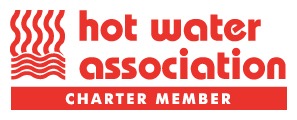Heating and building products are continually improving their efficiency to the point where, for many, further significant gains are no longer possible. So, should our attention turn to the important part a cylinder can play in improving efficiency?
Stuart Elsy, Managing Director of OSO Hotwater, looks at the changes in cylinder technology and why the latest advances can make a difference to the overall effectiveness of a heating system.
The new generation of hot water cylinders available offer considerable advantages over older products and can provide greater opportunities for house design and space utilisation.
The definition of a high-performance cylinder has shifted from a cylinder that heats up quickly, to one that cools down very slowly. Heat loss is the key factor here and keeping this to a minimum is the parameter by which indirect cylinders are assessed for SAP and ERP.
Heat loss used to mean a bare cylinder covered with an ill-fitting jacket, probably costing the home owner hundreds of pounds per year to maintain any level of temperature. Not to mention being hit by a wall of heat every time the airing cupboard doors were opened.
The move to spray foam insulation, still used in many vented cylinders although at an increased thickness, has made notable steps to improve heat loss levels. Almost all unvented and thermal store products tend to feature injection foam, which again ensures improvement.
However, if you are looking to increase the effectiveness of a heating system as a whole, it is worth for cylinders using vacuum panel insulation. This on its own can improve efficiency by 30-50% even when compared to injection foam models. Heat cannot travel through a vacuum, and a 10mm thick vacuum panel has the same effect as 60mm of the very best foam insulation. The panel is wrapped around the cylinder wall, and units is then “double lagged” with a layer of foam insulation that further reduces heat loss but also gives stability to the cylinder casing and protect the vacuum panel.
Overall cylinder efficiency is also now easier to understand too. All cylinders currently available have ERP ratings from A-C. Rather obviously, an A-rated cylinder will be cheaper to run. In fact, a large A-rated cylinder can save up to £80 a year in energy costs compared to a 15-20 year old cylinder that it replaces. OSO’s Delta range of cylinders utilise this vacuum panel insulation, and it is no coincidence that they are the only cylinders that are A-rated throughout the range to 300 litres.
Outside of vacuum panel models, cylinder ranges that have better ratings tend to have thicker insulation. A cylinder with 50mm of foam insulation is already well insulated. Marginal gains can be made by increasing the thickness to 60 or 70mm, but beyond that any gains are more than offset by the practical difficulties of squeezing a cylinder into a narrow airing cupboard.
Highly insulated cylinders, in reality, don’t need to go in an airing cupboard, increasing installation flexibility. In fact, the best cylinders can easily be fitted in a loft or garage. The small amount of additional heat loss that will occur because the ambient temperature is lower in those environments will be a small cost, when compared to the addition space created by removal of the cylinder from the first floor.
With this in mind, installers should think very carefully before suggesting the removal an old cylinder and replacing with a combi boiler. Cylinders have a fundamental advantage in houses with more than one shower/bathroom in that they are able to supply two or more showers simultaneously. Recent research conducted by the Hot Water Association, revealed that almost a quarter of families argue regularly about who is going in the shower first. This doesn’t have to happen with a cylinder.
Gains can be made where electric cylinders are concerned too. Direct cylinders are assessed for ERP on their thermal efficiency in line with heat in vs heat out. Cylinder insulation is clearly very important in this respect, but a new advance in smart controls by OSO has made a significant stride forward in cutting energy bills. The OSO Super SX iQ learns the hot water usage habits of a household, predicts demand and limits energy input to match demand. The resultant energy cost saving will amount to up to £60 per year at today’s electricity prices, and these prices are not going to go down in the future.
All of the above is about energy saving of the product, but to maintain efficiencies it is equally important to ensure that the interface of pipework between boiler and cylinder is correctly lagged and that modern heating controls are used.
Heating costs in indirect cylinders can also be affected by hard water. Opting for a coil which is smooth will attract and harbour far less limescale than a ribbed or finned coil, cutting the effect of Limescale acts as insulation between primary and secondary water. Building regulations Part L recommends that hard water is treated to reduce calcium and preserve the efficiency of the system. In the worst cases, cylinders can just fill up with limescale, and because the South-East and East of England in particular are known hard water areas, the design of a heat-exchange in a cylinder should always be a factor to consider for installers in those areas.
In conclusion, changing a hot water cylinder for a new highly efficient model is a sound financial investment and, with the latest advances in insulation and controls offering greater savings and flexibility, it opens avenues for installers needing to recommend effective and efficient options for customers.


